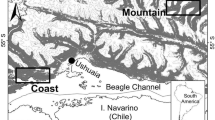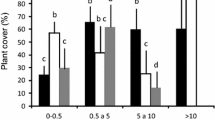Abstract
The rare forest plant Chimaphila umbellata (Ericaceae) has decreased drastically during the last century, approximately by 80 % in some regions in Sweden. We examined associations between various biotic and abiotic conditions related to changes in forest management and nitrogen deposition, and C. umbellata population size, flowering frequency, fruit set and seed production. Environmental conditions at 38 C. umbellata sites in the provinces of Uppland and Södermanland, Sweden, included light inflow, cover of competitive species, soil nitrogen, continuity of forest cover and soil texture. The results suggested that population size was negatively affected by cover of competitive species. Population size was not related to light availability although increased shading was associated with decreased flowering frequency. Fruit set was negatively affected by cover of competitive species, and seed production decreased with increasing soil nitrogen content. Fruit set and seed production increased with increasing population size. This study shows that denser forest stands and increased abundance of Vaccinium myrtillus and graminoid species may have strong negative effects on C. umbellata. This species’ longevity and clonal propagation may buffer some negative impacts, which in turn might contribute to an extinction debt. To maintain viable populations of Chimaphila umbellata in Swedish forests, there is a need for targeted management in forest habitats, i.e. reintroducing moderate disturbance regimes to reduce competition and increase light inflow.





Similar content being viewed by others
References
Bengtsson J, Nilsson SG, Franc A, Menozzi P (2000) Biodiversity, disturbances, ecosystem function and management of European forests. For Ecol Manag 132:39–50. doi:10.1016/s0378-1127(00)00378-9
Berg A, Ehnström B, Gustafsson L, Hallingbäck T, Jonsell M, Weslien J (1994) Threatened plant, animal, and fungus species in Swedish forests – distribution and habitat associations. Conserv Biol 8:718–731. doi:10.1046/j.1523-1739.1994.08030718.x
Bobbink R, Hicks K, Galloway J, Spranger T, Alkemade R, Ashmore M, Bustamante M, Cinderby S, Davidson E, Dentener F, Emmett B, Erisman JW, Fenn M, Gilliam F, Nordin A, Pardo L, De Vries W (2010) Global assessment of nitrogen deposition effects on terrestrial plant diversity: a synthesis. Ecol Appl 20:30–59. doi:10.1890/08-1140.1
Delin A (2013) Ryl – gynnad eller missgynnad av brand? Svensk Bot Tidskr 107:252–263 (in Swedish)
De Witte LC, Stöcklin J (2010) Longevity of clonal plants: why it matters and how to measure it. Ann Bot 106:859–870. doi:10.1093/aob/mcq191
Ehrlén J, Lehtilä K (2002) How perennial are perennial plants? Oikos 98:308–322. doi:10.1034/j.1600-0706.2002.980212.x
Ericsson S, Östlund L, Axelsson AL (2000) A forest of grazing and logging: deforestation and reforestation history of a boreal landscape in central Sweden. New For 19:227–240. doi:10.1023/a:1006673312465
Eriksson O (1996) Regional dynamics of plants: A review of evidence for remnant, source-sink and metapopulations. Oikos 77:248–258. doi:10.2307/3546063
Eriksson O, Ehrlén J (1992) Seed and microsite limitation of recruitment in plant-populations. Oecologia 91:360–364. doi:10.1007/bf00317624
Eriksson O, Kainulainen K (2011) The evolutionary ecology of dust seeds. Perspect Plant Ecol 13:73–87. doi:10.1016/j.ppees.2011.02.002
Eriksson O, Cousins SAO (2014) Historical landscape perspectives on grasslands in Sweden and the Baltic region. Land 3:300–321. doi:10.3390/land3010300
Freudenstein JV (1999) Relationships and character transformation in Pyroloideae (Ericaceae) based on ITS sequences, morphology and development. Syst Bot 3:398–408. doi:10.2307/2419697
Grime JP (2001) Plant Strategies, Vegetation Processes, and Ecosystem Properties. John Wiley & Sons Ltd, Chichester
Gärdenfors U (ed) (2010) Rödlistade arter i Sverige 2010. [The 2010 Red List of Swedish Species]. ArtDatabanken, Uppsala
Halpern CB, Spies TA (1995) Plant-species diversity in natural and managed forests of the pacific-northwest. Ecol Appl 5:913–934. doi:10.2307/2269343
Hedwall PO, Brunet J, Nordin A, Bergh J (2013) Changes in the abundance of keystone forest floor species in response to changes of forest structure. J Veg Sci 24:296–306. doi:10.1111/j.1654-1103.2012.01457.x
Hylander K, Ehrlén J (2013) The mechanisms causing extinction debts. Trends Ecol Evol 6:341–346. doi:10.1016/j.tree.2013.01.010
Hynson NA, Preiss K, Gebauer G, Bruns TD (2009) Isotopic evidence of full and partial myco-heterotrophy in the plant tribe Pyroleae (Ericaceae). New Phytol 182:719–726. doi:10.1111/j.1469-8137.2009.02781.x
Hynson NA, Mambelli S, Amend AS, Dawson TE (2012) Measuring carbon gains from fungal networks in understory plants from the tribe Pyroleae (Ericaceae): a field manipulation and stable isotope approach. Oecologia 169:307–317. doi:10.1007/s00442-011-2198-3
Johansson VA, Eriksson O (2013) Recruitment limitation, germination of dust seeds, and early development of underground seedlings in six Pyroleae species. Botany 91:17–24. doi:10.1139/cjb-2012-0153
Johansson VA, Müller G, Eriksson O (2014) Dust seed production and dispersal in Swedish Pyroleae species. Nord J Bot 32:209–214. doi:10.1111/j.1756-1051.2013.00307.x
Johansson VA, Mikusinska A, Ekblad A, Eriksson O (2015) Partial mycoheterotrophy in Pyroleae: nitrogen and carbon stable isotope signatures during development from seedling to adult. Oecologia 177:203–211. doi:10.1007/s00442-014-3137-x
Jones MD, Durall DM, Cairney JWG (2003) Ectomycorrhizal fungal communities in young forest stands regenerating after clearcut logging. New Phytol 157:399–422. doi:10.1046/j.1469-8137.2003.00698.x
Jonsell L (2010) Upplands flora [The flora of Uppland]. SBF-förlaget, Uppsala
Kellner O, Redbo-Torstensson P (1995) Effects of elevated nitrogen deposition on the field-layer vegetation in coniferous forests. Ecol Bull 44:227–237
Knudsen JT, Olesen JM (1993) Buzz-pollination and patterns in sexual traits in North European Pyrolaceae. Am J Bot 80:900–913. doi:10.2307/2445510
Kron KA, Judd WS, Stevens PF, Crayn DM, Anderberg AA, Gadek PA, Quinn CJ, Luteyn JL (2002) Phylogenetic classification of Ericaceae: Molecular and morphological evidence. Bot Rev 68:335–423. doi:10.1663/0006-8101(2002)068[0335:pcoema]2.0.co;2
Kudoh H, Shibaike H, Takasu H, Whigham DF, Kawano S (1999) Genet structure and determinants of clonal structure in a temperate deciduous woodland herb, Uvularia perfoliata. J Ecol 87:244–257. doi:10.1046/j.1365-2745.1999.00355.x
Larsson A, Thor G (2010) Pressures in the landscapes – the forests. In Gärdenfors U (ed) The 2010 Red List of Swedish Species. Artdatabanken, Uppsala, pp 85–92
Lezberg AL, Halpern CB, Antos JA (2001) Clonal development of Maianthemum dilatatum in forests of differing age and structure. Can J Bot 79:1028–1038
Maad J, Sundberg S, Stolpe P, Jonsell L (2009) Floraförändringar i Uppland under 1900-talet – en analys från Projekt Upplands Flora [Floristic changes during the 20th century in Uppland, east central Sweden]. Svensk Bot Tidskr 103:67–104
Manninen OH, Stark S, Kytoviita MM, Lampinen L, Tolvanen A (2009) Understorey plant and soil responses to disturbance and increased nitrogen in boreal forests. J Veg Sci 20:311–322. doi:10.1111/j.1654-1103.2009.05529.x
Östlund L, Zackrisson O, Axelsson AL (1997) The history and transformation of a Scandinavian boreal forest landscape since the 19th century. Can J For Res 27:1198–1206. doi:10.1139/cjfr-27-8-1198
Ozinga WA, Hennekens SM, Schaminee JHJ, Smits NAC, Bekker RM, Romermann C, Klimes L, Bakker JP, Groenendael JM van (2007) Local above-ground persistence of vascular plants: Life-history trade-offs and environmental constraints. J Veg Sci 18:489–497. doi:10.1111/j.1654-1103.2007.tb02563.x
Quantum GIS Development Team (2013) Quantum GIS Geographic Information System. Open source geospatial foundation project. Available at: http://qgis.osgeo.org
Rasband WS (2013) ImageJ, version 1.47v. National Institutes of Health, Bethesda, Maryland, USA. Available at: http://imagej.nih.gov/ij
R Development Core Team (2013) R: A language and environment for statistical computing. R Foundation for statistical computing, Vienna, Austria. Available at: http://www.R-project.org
Rydberg H, Wanntorp H-E (2001) Sörmlands flora [The flora of Sörmland]. Botaniska Sällskapet i Stockholm, Västervik
Selosse MA, Roy M (2009) Green plants that feed on fungi: facts and questions about mixotrophy. Trends Plant Sci 14:64–70. doi:10.1016/j.tplants.2008.11.004
SMHI (2013) Swedish Meteorological and Hydrological Institute. Total deposition of nitrogen. Available at: http://www.smhi.se/klimatdata/miljo/atmosfarskemi. Accessed 9 December 2013
Species Observation System (2013) The species observation system for plants, animals and fungi. Artdatabanken, SLU. Available at: http://www.artportalen.se
Strengbom J, Nordin A, Näsholm T, Ericson L (2001) Slow recovery of boreal forest ecosystem following decreased nitrogen input. Funct Ecol 15:451–457. doi:10.1046/j.0269-8463.2001.00538.x
Tamm CO (1991) Nitrogen in terrestrial ecosystems. Springer Verlag, Berlin
Tedersoo L, Pellet P, Koljalg U, Selosse MA (2007) Parallel evolutionary paths to mycoheterotrophy in understorey Ericaceae and Orchidaceae: ecological evidence for mixotrophy in Pyroleae. Oecologia 151:206–217. doi:10.1007/s00442-006-0581-2
Tilman D, May RM, Lehman CL, Nowak MA (1994) Habitat destruction and the extinction debt. Nature 371:65–66. doi:10.1038/371065a0
Vellend M, Verheyen K, Jacquemyn H, Kolb A, Calster H van, Peterken G, Hermy M (2006) Extinction debt of forest plants persists for more than a century following habitat fragmentation. Ecology 87:542–548. doi:10.1890/05-1182
Warming E (1918) Om Jordudløbere. A. F. Høst og Søn, Copenhagen
Wilson SD (1998) Competition between grasses and woody plants. In Cheplick GP (ed) Population Biology of Grasses. Cambridge University Press, Cambridge, pp 231–254
Zimmer K, Hynson NA, Gebauer G, Allen EB, Allen MF, Read DJ (2007) Wide geographical and ecological distribution of nitrogen and carbon gains from fungi in pyroloids and monotropoids (Ericaceae) and in orchids. New Phytol 175:166–175. doi:10.1111/j.1469-8137.2007.02065.x
Acknowledgments
We are grateful to V. Johansson, E. Meineri and H. Grudd for their help in conducting this study, and to two anonymous reviewers for comments on the manuscript. Thanks also to the landowners and the County Administrative Boards in Stockholm and Uppsala for permissions to conduct bores at the study sites, and to U. Johansson, A. Erixon and Å. Strid who provided information regarding C. umbellata sites.
Author information
Authors and Affiliations
Corresponding author
Rights and permissions
About this article
Cite this article
Lundell, A., Cousins, S.A.O. & Eriksson, O. Population size and reproduction in the declining endangered forest plant Chimaphila umbellata in Sweden. Folia Geobot 50, 13–23 (2015). https://doi.org/10.1007/s12224-015-9212-1
Received:
Accepted:
Published:
Issue Date:
DOI: https://doi.org/10.1007/s12224-015-9212-1




